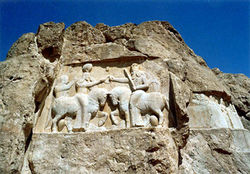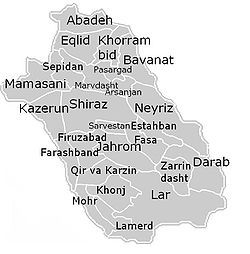Fars Province
Fars (Persian: فارس) is one of the 31 provinces of Iran. Located in the south of the country, its capital is Shiraz. It corresponds to the region traditionally called in Spanish Farsistan or Persia.
Fars is believed to be the original area of the Persian people and gives its name to the Persian or Farsi language. Persia is derived from the Greek. Fars is the Arabized form of Pars, since Arabic lacks the phoneme /p/.
Geography
Fars Province features two distinct geographic regions, separated by the Zagros Mountains, which run from the northwest to the southeast of the province. The northern part begins in the Samirum mountains and ends south of Abadeh, on Mount Azamat, where the Koli Kosh pass is located. Another mountain that stands out in this region is Barm Firuz, 3,673 m above mean sea level. Near Shiraz are Mount Sabz Pushan, Kuh-e Bamu, Kuh-e Tudaj and Khaman Kuh.
The most important river is the Kor River, which rises in the northern mountains, crosses the city of Marvdasht and flows into Lake Bakhtegan. Likewise, Maharloo Lake stands out.
The southern part also comprises highlands and includes the Maharloo, Kharman and Toraj mountains, which link the highlands of Kohkiluyeh province with the Mamesani mountains, and includes the Darab mountains and the Tangistan highlands.
There are three climatic regions. The first covers the northern, western and northwestern part of the mountainous region, and is characterized by its cold and temperate climate, as well as its significant green terrain. The second region is located in the center of the province, it is characterized by having a winter of moderate temperatures and considerable rainfall, and a hot and dry summer. The third region is located to the south and southeast of the province, in a shallow area, which is significantly dry and has moderate temperatures in winter, and very hot summers. The city of Shiraz has an average temperature of 16.8 °C, with an average maximum temperature of 29.2 °C, and an average minimum of 4.7 °C.
History and culture
Pre-Islamic Persia
Achaemenid Persia
The region of Fars was the cradle of the Persian Empire. The first inhabitants of the region were the people of Elam, who lived in Anshan, near Shiraz, within the current province of Fars, around the 3rd millennium BC. C. However, in the middle of the II millennium B.C. C. would make Susa their capital, in the current province of Juzestan.
Even so, the Achaemenids were the first to create a centralized state in Persia around 700 B.C. In the absence of historical evidence, it is legendarily attributed to the Achaemenid Teispes (son of Achaemenes according to Greco-European sources not confirmed by Persian texts) who led the nomadic Persians to settle in southern Iran in Anshan, founding Istakhr (also in Fars), while Elam succumbed to the Assyrian empire of King Ashurbanipal around 640 B.C. C. After his death, the Assyrian Empire would disintegrate before the attack by the Medes, Babylonians and Scythians. Established in Fars, the Achaemenids would be divided into two ruling houses: the Persian and that of Anshan, which would be unified during the reign of Cyrus II the Great, founding the Achaemenid Persian Empire. Cyrus II established his capital at Pasargada, the empire's first capital, and undertook a period of conquest towards the middle of the 6th century BC. C., taking Media, Lydia and Babylon. However, Ciro II fell in combat, leaving Pasargarda unfinished. His successor, Cambyses II, would move the capital to Babylon.
Around 512 B.C. C. King Darius I the Great undertook the construction of a new capital, Pārsā, known to the Greeks as Persepolis, and in present-day Iran as Takht-e Jamshid, thus returning the capital to Fars, and giving his name to the empire and province. During the reigns of the following emperors, Persepolis would be architecturally enriched. However, these did not reside in the city, since they generally lived in Susa, Babylon or Ecbatana, due to which the Greeks hardly knew about it.
Province of Persia during the Macedonian and Seleucid Empires
Persepolis, and its splendor, would see the end of its days when it was sacked and totally destroyed by Alexander the Great around 330 BC. C. Even so, it remained the capital of the Macedonian province of Persis, gradually declining. Alexander the Great would devastate other cities in Fars, such as Gōr, flooding it with the waters of a nearby river, and Istakhr, burning the original of the Avesta, which was located in this city.
After the death of Alexander the Great, the Macedonian Empire fragmented, with fighting between Macedonian generals. One of them, Seleucus I, was appointed satrap in 321 B.C. C., and shortly after king of Babylon, giving rise to the Seleucid Dynasty. Being such a sprawling and ethnically distinct kingdom, it was difficult to control; the Persian people, in Persis, together with the Medes and Bactrians took advantage of the problems of the Seleucid Empire to become independent. However, a second Iranian dynasty coming from the Parni people would have to prevail: the Arsacid that would found the Parthian Empire.
Parthian Province
Mithridates I of Parthia dominated several Seleucid provinces (eg Media, Susiana, Caracene, Babylonia, Assyria), and among them the province of Persis around 139 BC. C. However, he established his capital in Ctesiphon, a city located in present-day Iraqi territory. The empire functioned as a confederation of kingdoms, provinces and city states, which at times helped to weaken the Parthian state, among which was Pars (Fars).
Sasanian Empire
Around 208, Ardashir I crowned himself king of Balkh, a vassal kingdom of Parthia, with whom he would have to confront and win. Around 226, he crowned himself King of Kings, Šāhānšāh, ending 400 years of the Parthian Empire, slaying his last sovereign, Artaban IV, and initiating the Sassanid Dynasty. Ardashir I rebuilt and set his capital at Istakhr. He built Ghal'eh Dokhtar Castle and Ardashir Palace, both in Fars province, near ancient Gōr, present-day Firuzabad, reviving this city, which was known as Kūh Ardeshīr, Ardeshīr Khurah and Shāhr-ī Gōr. However, Ardashir I soon after moved his capital to Ctesiphon. The Sasanian kings would use the palaces in Fars as summer residences.
Islamic Persia
Arab conquest
In the spring of 632, as the last Sassanid ruler Yazdegard III took possession of the kingdom, the Arabs began making their first inroads into Persian territory, coinciding with the economic decline and feudal infighting of the Sassanid Empire. This succumbs after the fall of Ctesiphon in 637 and the Battle of Nihawānd in 642. Fars would pass into Arab hands around 643. Despite offering resistance, the city of Istakhr fell into Arab hands, being destroyed for the second time. Other towns in Fars suffered a similar fate, such as Firuzabad.
Persia, essentially Zoroastrian, converted to Islam, eventually adopting Arabic calligraphy, although it retained its own Persian language, since according to Islam people have the right to retain their original language. The Iranian Samanid dynasty, which ruled the Central Asian plains, would promote the use of Persian.
In the years that followed, a new metropolis emerged in Fars, Shiraz, at the same time other cities such as Firuzabad were being rebuilt. Around 960, 'Adud al-Daula would carry out the project of building a dam, called Band-i Amir, located between Istakhr and Shiraz, which would irrigate around 300 villages.
The region of Pars would have to pass into the political background, since the new Persian dynasties settled in northern Iran and in the current Central Asian republics, taking their culture with them, and promoting it in those regions. Away from Iranian neuralgia, the province of Pars came under Umayyad Arab influence at first, followed by the Abbasids, followed by the brief dynasties of the Buwayids (934-1062), followed by the Seljuk Turks., the Khwarezmids, who were devastated by the Mongols of the Ilkhanate.
Injuid and muzafarid period
Around 1304, the Inyuids, at the beginning of the reign of Khan Öljeitü, imposed themselves in the Fars region, taking advantage of the Khan's concessions to administer the injü, territorial possessions. As the Injuids gained power, Khan Abu Sa'id, son of Öljeitü, confronted them in 1325. Kai-Khusrau, governor of Shiraz, withstood the Khan's attack, but had to confront his brother Mas'ud Shah for the power struggle. In the end, it would be Abu Ishaq, another brother, who remained in power, being the only son of Sharaf al-Din to survive the family struggle around 1343. His ambition led him to march against the muzafarids of Yazd around 1350. These, led by Mubariz al-Din, invaded the province of Fars in 1352 and besieged Shiraz in 1353. In his paranoia, Abu Ishaq had people from two neighborhoods of the city murdered to eliminate traitors. The head of another neighborhood, fearing for his people, gave the keys to the access gate of his neighborhood to Shah Shuja, son of Mubariz al-Din. Abu Ishaq fled to Isfahan. Mubariz al-Din advanced on, besieged and conquered Isfahan around 1357. Abu Ishaq was captured and sent to Shiraz, where he was executed. In this way, the muzafarids would prevail in Fars for forty years, making Shiraz their capital, until the arrival of Tamerlane.
Temurid Period
In April 1393, Tamerlane invades Fars, defeating and eliminating the Muzafarids, who were in a family struggle for power. In this way, Fars becomes a province of the Temurida Empire. During these years, the center of Iranian culture was in Samarkand, since the south of Iran was in ruins after years of wars.
Fars since 1500
As the Temurid Empire weakened, the Safavids conquered Shiraz around 1504, imposing the Shi'a cult as the official religion, not only in Fars, but throughout Iran as they expanded. In this way, cultural splendor returned to the central plains of Iran, since the Safavids would eventually make Isfahan their capital, Fars being located to the south of it.
Around 1760, after the death of Nadir Shah and an internal war for power, Karim Khan had himself appointed king (but not Shah) and established Shiraz as the capital, making it the cultural and commercial center of Iran, bringing prosperity to the province and regions he controlled, allowing the British East India Company to establish itself. It would be the Qayar dynasty that would move the capital to Tehran in 1796, since then located there.
Political division
The province of Fars is subdivided into shahrestans, or provinces, which are:
- Abade (liceباده).
- Arsanyán (ارسنجان).
- Bavanat (بوانات).
- Darab (داراب).
- Eqlid (اقلید).
- Estahban (استهبان).
- Farashband (فراشبند).
- Fasá (فسا).
- Firuzabad (فیروزباد).
- Yahrom (جهرم).
- Kazerún (уارون).
- Jonch (Corporal Market).
- Jorrambid.
- Lamerd (لامرد).
- Lar.
- Mamasaní (ممسنی).
- Marvdasht (مرودشت).
- Mohr (Andalus Reconnaissance).
- Neyriz.
- Qirokarzín (قیر و دارین).
- Sepidán (س.
- Shiraz (شیراز).
- Zarrindasht (زرین دشت).
Contenido relacionado
511
491
145





